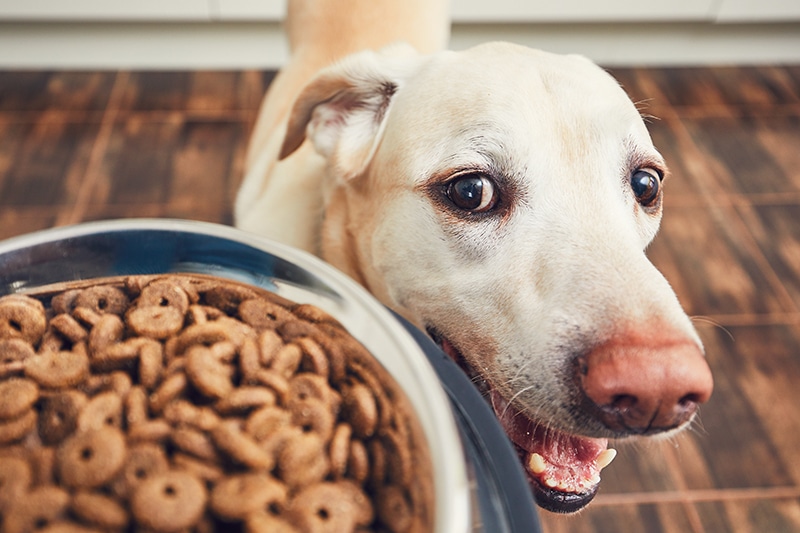“What’s a Labrador Retriever’s favorite musical instrument? The dinner bell!” (We know you’re laughing!). As a large-energetic breed, you need to keep your lab’s diet balanced so that she wouldn’t gain or lose weight. Therefore, you have to make plenty of decisions, from considering Fido’s life stage and health requirements to ensure that she gets all the proper nutrients from the highest quality sources. All of this with the abundance of information might be overwhelming.
I used my 12 years of Veterinary experience and reviewed over 100 dog food products to find the best dog food for labs.
After considering the nutritional needs along with genetic health conditions that Labs tend to have, I found that “Earthborn Holistic Large Breed Pea-Free” is the best overall food for adult Labradors. In addition to meeting my dietary criteria for Labs, it has the best combination of nutrients and quality sources.
But I understand that no two Labradors are alike, and your Lab might have a different life stage or have different needs. That’s why I prepared a shortlist of the best Labrador foods that address the most common Labrador needs.
In addition to picking the best products for your pooch, I outlined my process for choosing dog food. I want you to know what gets inside the furry stomach. The process is written in plain & simple English that will help you make wiser dietary decisions for your Lab.
I encourage you to read our review process and check out our in-depth reviews below so that you’ll be able to come up with your own dietary decisions.
Let’s get started.
Before You Pick The Best Food For Your Labrador
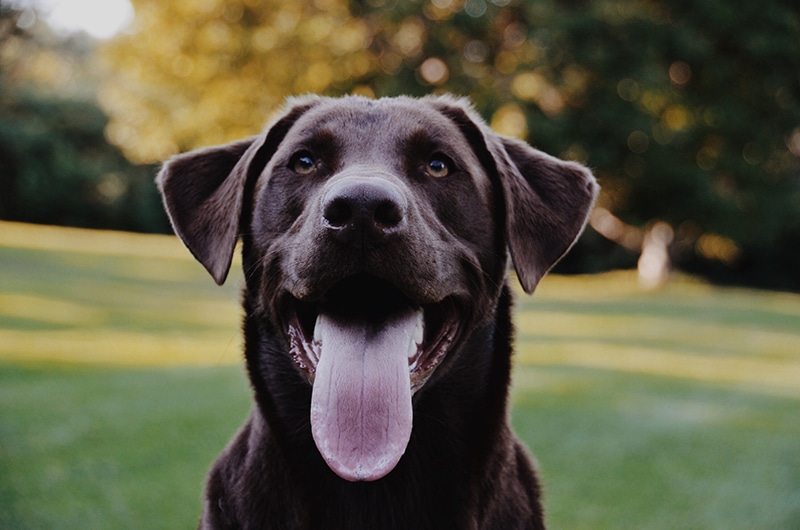
There’s no such thing as one food that fits all Labradors. While I did my best to find the best food for most Labs, you might prefer to pick a more specific formula.
That’s why I elaborate here our main considerations while reviewing the best dog foods for Labs.
You can divide your research journey into 3 steps:
- First, pick the right food for your Lab’s life stage – Puppies, Adults, and Senior Labs are in different development stages. Their joints, bones, and muscles develop at a different pace. That’s why you’ll need to pick the proper nutrients in the correct quantity for your Lab’s life stage.
- Picking the right food to reduce common Lab health issues – Each dog breed has an increased risk of catching certain health conditions. These health conditions are genetic, and Labradors are not indifferent. So make sure to pick the right ingredients to support common Labrador health issues.
- Picking suitable nutrient sources – Sometimes two dog foods might seem similar. Both could provide the same nutritional value. However, it’s essential to question how these nutrients were sourced. We want to avoid chemicals and low-quality nutrients that can introduce some side effects.
The rest of the guide will show you how to pick the right food for your Lab’s life stage, how diet helps in common Labrador health issues and what to look for on the label.
For your convenience, I (Dr. Libby Guise) shortlisted 15 dog foods. These foods were carefully selected and should satisfy your Lab’s needs. I also noted which food is best for certain life stages or particular health issues.
After going through the shortlist, you can find additional considerations that might be of interest to you and your fur-baby.
Finally, I answered the most popular questions that I’m being asked regarding Labradors’’ nutrition and diet.
Please keep in mind, while I tried to do my best to find the best food for your Labrador, it would be a good idea to understand how and why we made our decisions.
The recommendations in this review are not intended to replace the doctor-patient relationship. Always consult your veterinarian before making major adjustments to your furbaby’s diet.
The Right Diet For Puppies, Adults, And Senior Labradors
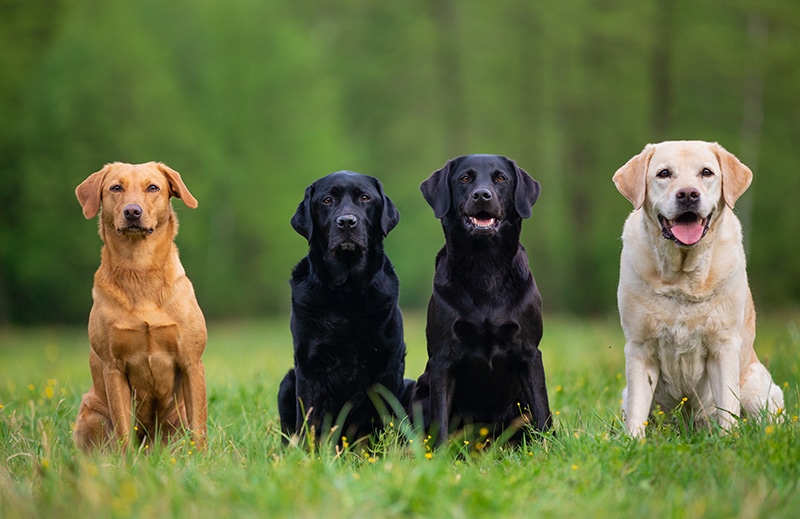
One of the most high energy breeds, the Labrador is an intelligent and super-active pooch. At each life stage Lab will need to consume different nutrients and would need to consume a different amount of calories.
Before we get started: The information and recommendations in this review are general guidelines, but every dog is different. Always consult with your veterinarian before switching your pal’s food.
- Puppies – As large-breed dogs, these furballs grow rapidly. They can gain about 75 times their birth weight by the time they’re an adult. Labrador puppies require a proper balance of calcium. If there’s an excess of the mineral, bones may grow too fast and become deformed. On the other hand, too little calcium can also be problematic.
Because of the larger bones and genetic predispositions, it’s also important to keep lab puppies from packing on the pounds. Extra weight can put stress on the bones and joints. Therefore, these pooches need food that’s lower in fat and calories than the standard puppy food.
- Adults – Adult labs are active and require higher protein from animal sources to support muscle mass. Moderate fat from healthy sources that provide essential fatty acids helps to fuel your pal’s lifestyle.
This breed is also susceptible to skin, joint, and eye conditions. They need a balance of vitamins and minerals for whole-body health and immunity. Look for whole food ingredients from vegetables and fruits.
- Seniors – Much like us, labrador needs change as they age. Their metabolism and energy levels drop, and too many calories can lead to unwanted weight gain. Provide free-choice water and food with lower energy density. Continue to provide high-quality proteins from real meats to help maintain lean muscle mass.
With age, the bowels become less efficient, so they need highly digestible ingredients and extra fiber to keep them regular. Dogs also need more liquids to prevent dehydration and unbalanced electrolytes.
Aging labs can suffer from joint pain, eye problems, and other degenerative conditions. Look for supplements such as glucosamine, chondroitin, omega fatty acids, and antioxidants.
Daily Calorie Requirements
Labrador Retrievers were originally bred to be working dogs, they tend to be athletic and energetic.
The average adult needs about 1000 to 1200 calories per day, but that can vary depending on your pup’s size, age, and activity level. Use these guidelines as a starting point and adjust up or down if your pal seems to be putting on pounds or gaining weight.
You can use the following formula to get a more precise target:
- Puppies under 4 months: RER* X 3
- 4 months to adult: RER* X 2
- Adults: RER X 1.8 for normal activity; RER X 4 for high activity/performance Labradors
- Seniors: Many senior labs remain active. Start at RER X 1.8 and adjust downward if your pal is gaining weight.
*RER is the resting energy requirement, which is equal to body weight in kilograms times 30 plus 70.
Feeding Quantity & Frequency
Once you know how many calories your pooch should need, you can check the calorie content of your food to figure out how many cups to feed. You can also use the feeding guidelines on the packaging as a good starting point, as it is based on your dog’s age and weight.
How many times a day you should feed your furbaby will depend on his age.
- Puppies – puppies burn energy stores faster than adults, so they require more frequent meals. For young puppies (up to about 3 months), feed them four meals spaced throughout the day. Once they reach 3 months, you can taper down to three meals until the pups are about 6 months. After the first 6 months, puppies can handle morning and evening feedings.
- Adults and Seniors – We recommend staying with two meals a day if you’re feeding kibble. If you choose a raw meat diet, you may be able to feed once a day.
The Appropriate Nutrition For Common Labrador Health Issues

Some health conditions are more popular among Labradors than other dog breeds. Each breed inherits some genes that can be associated with certain health issues.
It doesn’t mean that Fido is going to develop these conditions, it just means that Labradors have a higher chance as compared to other breeds.
However, it’s possible to reduce the risk by proactively feeding Labrador with the right nutrients. Here we list the most common Labradors health issues and how certain nutrients can reduce risk.
A quick reminder: if you think your special pal suffers from any of these conditions, schedule an exam with your veterinarian to confirm your suspicions. Even with healthy dogs, these dietary recommendations may help prevent future problems. Always check with Fido’s doctor before making changes in his diet.
Eye Problems
Two major eye problems affect Labradors:
- Progressive Retinal Atrophy – In progressive retinal atrophy, the retina slowly deteriorates leaving your pup blind or with limited peripheral vision by about 6-8 years of age. This disease is genetically inherited.
- Retinal Dysplasia – Another inherited disease in Labradors is retinal dysplasia. In this condition, the layers of the retina fail to form properly and wind up folding on one another. The result is that the affected dog has blind spots. For some pups, the spots are barely noticeable. Others suffer from severely impaired vision.
There is no cure for either disease, but you may be able to slow progression with proper nutrition. Antioxidants, Vitamin A, and beta-carotene from fruits and vegetables as well as omega fatty acids can help support eye health.
Joint Disease
Labrador retrievers may suffer from several joint maladies.
- Hip and Elbow Dysplasia – In hip and elbow dysplasia, the respective joint fails to form properly, and the bones have too much room to move around. This leads to rubbing and damage to the cartilage, pain, lameness, and degenerative joint disease as your pooch ages.
- Cruciate Ligament Injury – A cruciate ligament injury can occur during activity or as a result of degenerative change. When this supporting ligament is damaged, dogs lose joint stability and will become lame. A sudden tear is the most severe type of cruciate injury.
- Panosteitis – As a large breed dog, Labradors grow quickly. Sometimes these pups will develop a painful condition known as panosteitis or inflammation of the outer surface of a long bone (aka growing pains). This condition presents as an intermittent lameness that may shift between limbs.
- Arthritis – Arthritis is an inflammation of the joints that usually occurs when the cartilage starts to break down. It’s more common in older dogs as they experience degenerative changes. Pups with arthritis may demonstrate pain in one or more joints, lameness, a reluctance to move, or difficulty getting up.
Regardless of the condition, there are some things you can do with Fido’s diet to help minimize the effects of joint disease. A diet that has a proper balance of the minerals calcium and phosphorus helps to ensure healthy growth and strength. Food with glucosamine and chondroitin provides important macronutrients for cartilage and joint health.
Obesity
Labradors are notorious for being food vacuum cleaners. They like to gobble anything in sight, and that means they’re prone to pack on extra pounds. The problem is that excess weight puts stress on the joints and heart. You can help prevent obesity by following feeding guidelines and keeping extra treats to a minimum. If your pooch is overweight, try a food that’s high in protein but has lower fat and lower calories.
Hypothyroidism
When the thyroid gland fails to produce enough of the hormone, thyroxine, there are several results. Dogs may gain weight, lose hair, become more lethargic, and be less tolerant of the cold among other symptoms. Healthy diet choices to help manage hypothyroidism in a dog include:
- Whole food ingredients
- Lean proteins
- High protein content
- Grain-free
- Digestible ingredients
- No artificial additives
Skin and Coat Problems
There are several conditions that can affect your Labrador’s skin and/or coat:
- Allergies – if your pooch has a food sensitivity or reacts to something in the environment, you may see red, itchy skin and a dull hair coat.
- Acute moist dermatitis – Also known as hot spots, dogs with this condition repetitively scratch or lick a patch of skin until it becomes inflamed. This is usually due to an allergic reaction but may also be a sign of anxiety.
- Atopic dermatitis – Seasonal allergies can cause skin inflammation.
- Acral lick dermatitis – When your pooch continually licks a spot, it can develop a raised nodule known as a lick granuloma. Food or seasonal allergies are the most likely cause of this condition.
- Folliculitis – Usually caused by allergies, folliculitis is an inflammation of the hair follicles that causes itching, redness, swelling, and possibly pustules.
- Seborrhea – With seborrhea, dogs have an increased shedding of skin. It can occur in a dry, flaky form or an oily form. Either way, the diet may help minimize or prevent the condition.
Dietary support for healthy skin and coat can help manage these conditions. Because many of them may be linked to food allergies or sensitivities, it’s helpful to look for food with natural ingredients, no grains and avoids common food allergens such as soy and gluten. Whole foods that are rich in antioxidants and omega fatty acids help to nourish the skin and coat and keep them healthy.
Epilepsy and Seizures
When a dog has a seizure, the brain has a sudden surge of activity that causes drooling, twitching, convulsions, and other spasms. While they can occur as an isolated event, they’re more commonly tied to the pooch having epilepsy in which periodic seizures occur. Some Labrador Retrievers may have a genetic predisposition to developing epilepsy.
Pups with canine epilepsy may require an anti-seizure medication, and diet can influence its effectiveness. Look for foods that don’t have any artificial ingredients and are lower in salt, as chloride may interfere with the drug. Products with quality proteins and essential fatty acids can support healthy brain function. Avoid soy, dairy, complex carbohydrates, and gluten as they may trigger seizures for various reasons.
Ear Infections
With their floppy ear flaps that cover the canal, Labradors are prone to ear infections from yeast or bacteria. Pups with infections may continually scratch their ears, have dark goopy wax, have reddened lobes, or cry when you rub their ears. Some inflammation and infections can be triggered by allergies.
If your pooch shows signs of an ear infection, talk to your veterinarian. You may need antibiotics or other treatments to clear up the condition. When choosing Fido’s food, look for ingredients that supply omega fatty acids for healthy skin and vitamin E to boost immunity. Whole foods that are a rich supply of antioxidants will also contribute to the body’s ability to fight off infections. Because allergies may play a role, avoid allergenic foods such as soy, wheat, and corn in the diet.
Heart Disease
Some Labradors are born with a valve defect
on the right side of the heart. This condition is most common in males and usually will not show signs until later in life. As an affected pooch ages, it may develop a heart murmur. Severe cases can progress to congestive heart failure (CHF).
Older dogs that show signs of CHF such as coughing, fatigue, weight loss, and a swollen abdomen should have a vet check-up. Fido’s doctor can prescribe medications to help manage the condition. As for diet, look for foods that are low in sodium and include nutrients that may support heart health:
- B-vitamins
- Taurine
- L-carnitine
- Antioxidants
- Vitamin E
In addition to CHF, some labradors may suffer from a taurine deficiency. Taurine is an amino acid that supports heart and retinal health. Preliminary studies suggest that supplementation with this amino acid can be a useful supportive measure in the treatment of heart disease.
Bloat
As notorious food gulpers and broad-chested canines, Labradors have a tendency to develop bloat or a twisted stomach. With bloat, the stomach fills with gas and twists, and this can be deadly if you don’t seek immediate veterinary care.
The causes of bloat aren’t well-defined, but there are some things you can do that may reduce the risk. First, try feeding your pooch smaller, more frequent meals to reduce the volume of food in the stomach. You can also use a slow feed dog bowl to encourage your pooch to stop gulping dinner.
Skin Allergies
Labradors can develop allergies to food or irritants in the environment. When allergies affect the skin, you may see scratching, red skin, flaky skin, or hair loss. If your pup has food-related skin allergies, you’ll want a hypoallergenic diet. Look for:
- whole protein from novel sources such as duck or venison
- Grain-free
- Limited ingredients
- No artificial additives
Exercise-Induced Collapse
Some labs carry a genetic trait that may cause them to become weak or collapse following intense physical exertion or periods of stress. When a pup is prone to exercise-induced collapse, it may become wobbly, fall over, or drag its hind legs as soon as 5 to 20 minutes after beginning to exercise. However, most dogs will fully recover within about 25 minutes.
While there is no treatment for the condition, you can manage it effectively. Limit your pal’s activity and stop as soon as you notice signs of weakness.
Ensuring High-Quality Nutrients
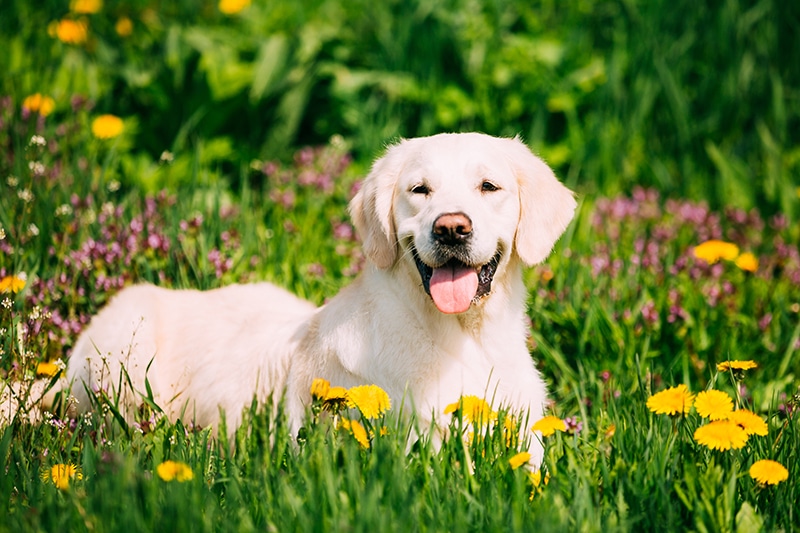
Now that you have information about the basic nutritional needs of Labradors and how to adjust their diets to prevent some common health conditions, we need to ensure that the nutrient sources are best of class.
- Kibble Size- As large dogs, labradors should have a kibble size that’s suitable for their breed. Choose medium to large-sized chunks that are easy to chew but difficult to wolf down.
- Age Appropriate – Remember, labradors have different nutrient needs depending on their life stage. So choose food that’s appropriate to your pup’s age.
- Digestible Ingredients – Because labs can suffer from food sensitivities, choose products that have readily digestible ingredients. Avoid complex carbohydrates. Instead, choose foods from fruits, vegetables, and whole grains that are gentle on the gut.
- Quality Protein From Animal Sources – Labrador Retrievers need a high protein diet from quality sources. Look for foods that have real meat ingredients as the first items on the list. Avoid animal by-products and derivatives.
- No Artificial Ingredients – Artificial additives can contribute to health concerns, including food sensitivities and cancer. Choose products that have no artificial colors, flavors, or preservatives, such as Ethoxyquin, BHA, BHT, propylene glycol, or sodium nitrate/nitrite in the ingredient list.
- Free From Fillers – Avoid fillers such as corn, gluten, and cereals that add unwanted caloric content but don’t add nutritional value.
- Nutritionally Balanced – Look for foods with a balanced blend of vitamins and minerals, including a controlled mixture of calcium and phosphorus to support your pup’s health needs. You’ll also want a product that’s high in protein and has low to moderate fat from healthy sources for your pal’s energy needs.
- Enriched With Helpful Supplements – Because of the health issues we discussed above, you should look for products that contain helpful supplements:
- Glucosamine and chondroitin for joint health
- Taurine to support the heart
- omega fatty acids to provide nutrients for the hair, skin, and brain
- Probiotics that aid healthy digestion
- Low to Moderate Fat – Look for healthy fats from omega fatty acids that supply energy for your active pooch. Keep the content low to moderate to prevent unwanted weight gain.
- Meets AAFCO nutritional requirements – Look for a statement on the package that the formula meets the nutritional requirements for the AAFCO. This voluntary organization conducts scientific research on pet foods and provides recommendations to regulatory agencies.
- Contains Limited Ingredients – Limited ingredients can help you manage food allergies and sensitivities. If you know what foods to avoid, you can focus on products with a shortlist of whole foods.
- Manufactured and Sourced in a Handful of Countries – Look for products made in countries like the USA, Canada, and other nations that rely on good manufacturing practices and clean ingredients.
Our 2025 Review For 15 Dog Foods For Labradors

We reviewed over 100 products by following the process presented above and classified the best of them based on common Labs needs.
We considered the life stage, common Labrador health issues and ensured it has the best nutrient sources for each pick.
Earthborn Holistic — Large Breed Dry Dog Food
- First 5 ingredients: Chicken Meal, Brown Rice, Tapioca, Oatmeal, Pearled Barley
- Key feature: Holistic food for Large Breed Dogs
- Guaranteed Analysis: 26% Crude Protein,13% Crude Fat,3% Crude Fiber, 10% Moisture
- Caloric Content: 360 kcal/cup
- Type of Product: Dry Food
- Life Stage: Adults
- Best for: Overall Pick
- AAFCO Statement: formulated to meet the nutritional level established by AAFCO Dog food nutrient profile for maintenance of adult dogs
With high protein and moderate fat, this product is formulated to meet the needs of a healthy labrador. The top ingredient is from animal protein sources to give your pup the building blocks for healthy lean muscle mass.
The energy density is suitable for an active lab without being too high. Digestible whole grains and healthy fats help to fuel your pup’s metabolism. There are no peas, legumes, or lentils in the formula.
Whole food ingredients including cranberries, apples, and carrots provide antioxidants, essential minerals, and vitamins for total health. The formula includes ingredients that provide omega fatty acids for healthy skin and coat, taurine for heart health, and glucosamine and chondroitin to support joint function.
Owners report their dogs love the flavor, and the kibble is the right size for their large breed dogs.
ORIJEN Puppy Dry Dog Food for Large Breeds
- First 5 ingredients: deboned chicken, deboned turkey, flounder, eggs, whole Atlantic mackerel
- Key feature: High protein, grain-free
- Guaranteed Analysis: 38% Crude Protein, 16% Crude Fat, 6% Crude Fiber, 12% Moisture
- Caloric Content: 449 kcal/cup
- Type of Product: Grain-free, dry
- Life Stage: Puppy
- Best for: Labradors Puppies
- AAFCO Statement: Orijen is formulated to meet the nutritional level established by the AAFCO Dog food nutrient profile for all life stages
With 85% of the ingredients coming from animal sources, Orijen Puppy food offers protein-rich nutrition for developing lean muscle mass. The fat content comes from healthy sources and offers omega fatty acids to support the skin, brain, and coat.
The formula has a balanced blend of vitamins and minerals including the proper amount of calcium and phosphorus to support rapidly growing long bones. Animal-based sources of glucosamine and chondroitin provide nutrients for joint health.
The diet includes digestible ingredients and at least 100,000,000 CFU/lb of probiotic organisms for gut health. There are no artificial ingredients or fillers in the product.
Customers who bought this product share that their large breed dogs grow well when eating the food, and many chose it because their veterinarian recommended it.
Nulo Senior Dry Dog Food
- First 5 ingredients: Deboned Trout, Turkey Meal, Salmon Meal, Yellow Peas, Sweet Potato
- Key feature: Protein-rich
- Guaranteed Analysis: 30% Crude Protein, 12% Crude Fat,5% Crude Fiber, 10% Moisture
- Caloric Content: 396kcal/cup
- Type of Product: Grain-free Dry Dog Food
- Life Stage: Senior
- Best for: Senior Labradors
- AAFCO Statement: formulated to meet the nutritional levels established by the AAFCO Dog Food Nutrient Profiles for Maintenance
This high-protein, low-moderate fat formula from Nulo provides your aging pooch with the energy and amino acids he needs for a healthy lifestyle. Real meat sources from trout, turkey, and salmon give the nutrients to maintain lean muscle mass.
As a grain-free formula, this product has whole fruit and vegetable ingredients including apple, tomato, and carrot to provide a rich source of antioxidants and essential nutrients. Prebiotic fiber from chicory root and probiotics further support digestive health.
Your senior pup will have nutrients for healthy bones and joints when he eats this food. It has a balanced blend of calcium and phosphorus and rich natural sources of glucosamine and chondroitin.
Owners who fed their seniors this food share that it helps keep the coat sleek and shiny and poops firm and regular.
American Journey — Large Breed Chicken & Brown Rice Protein First Recipe Dry Dog Food
- First 5 ingredients: deboned chicken, chicken meal, brown rice, peas, rice bran
- Key feature: High-protein, moderate fat
- Guaranteed Analysis: 24% Crude Protein,13% Crude Fat,6% Crude Fiber, 10% Moisture
- Caloric Content: 332kcal/cup
- Type of Product: Dry Dog Food
- Life Stage: Adult
- Best for: Budget
- AAFCO Statement: formulated to meet the nutritional levels established by the AAFCO Dog Food Nutrient Profiles for maintenance
With high protein and moderate fat content, this food provides the nutritional support a healthy lab needs. The main ingredient is real chicken which supplies key amino acids for lean muscle mass.
With fish oil and flaxseed to provide omega fatty acids, the formula offers support for a healthy brain, coat, and skin. Chicken meal offers a natural source of glucosamine and chondroitin for joint health.
The formula includes nutrient-rich fruits and vegetables to help provide a balanced blend of vitamins, minerals, and antioxidants. Digestible grains and healthy fats help to fuel an active lifestyle.
Owners report they love the wholesome ingredients, and so do their dogs. They also love that it provides an affordable and nutritious option.
Nutro Ultra Adult Dog Food
- First 5 ingredients: Chicken, Chicken Meal, Brown Rice, Brewers Rice, Rice Bran
- Key feature: Protein-rich
- Guaranteed Analysis: 25% Crude Protein, 14% Crude Fat,4% Crude Fiber, 10% Moisture
- Caloric Content: 341 kcal/cup
- Type of Product: Natural Dry Dog Food
- Life Stage: Adult
- Best for: Adult
- AAFCO Statement: formulated to meet the nutritional levels established by the AAFCO Dog Food Nutrient Profiles for Maintenance
This formula relies on three animal protein sources to provide your pup with the building blocks for healthy muscles. A moderate fat content featuring healthy fatty acids gives your pooch the fuel he needs to remain fit and active.
Digestible whole food ingredients from fruits and vegetables such as kale, pumpkin, blueberries, and apples offer a natural source of antioxidants and vitamins for total health. Omega fatty acids from salmon support the skin and coat.
The formula includes prebiotic fiber for healthy digestion, a balanced blend of minerals, and taurine. Natural sources of glucosamine and chondroitin support joint health.
Owners who chose this food report that their dogs love the flavor, and they have healthy coats and digestion when they eat it.
Sport Dog Food Active Series Field Dog Chicken & Sweet Potato Formula Flax-Free Dry Dog Food
- First 5 ingredients: Chicken Meal, Whole Ground Sorghum, Dried Sweet Potato, Turkey Meal, Whole Ground Millet
- Key feature: High-protein performance food
- Guaranteed Analysis: 29% Crude Protein, 14% Crude Fat,3.5% Crude Fiber, 9% Moisture
- Caloric Content: 483kcal/cup
- Type of Product: Dry Dog Food
- Life Stage: Adult
- Best for: Active Labs
- AAFCO Statement: formulated to meet the nutritional levels established by the AAFCO Dog Food Nutrient Profiles for Maintenance
Packed with animal protein and a balanced blend of digestible fats and carbohydrates, this food is designed to fuel an active lab lifestyle.
Real chicken meal is the first ingredient, and it provides essential amino acids for lean muscles and a natural source of glucosamine and chondroitin for healthy joints.
Whole grains, fruits, and vegetables provide digestible carbohydrates for energy, antioxidants, and essential vitamins for total health. Prebiotic fiber and probiotics add to digestive health.
Customers report that their dogs love this food and have plenty of energy when they eat it.
Wellness — Large Breed Complete Health Adult Deboned Chicken & Brown Rice Recipe Dry Dog Food
- First 5 ingredients: deboned chicken, chicken meal, ground brown rice, peas, oats
- Key feature: High protein, lower fat for weight loss and maintenance
- Guaranteed Analysis: 26% Crude Protein,12% Crude Fat,6% Crude Fiber, 10% Moisture
- Caloric Content: 340kcal/cup
- Type of Product: Natural ingredient dry dog food
- Life Stage: Adult
- Best for: Heart Health
- AAFCO Statement: formulated to meet the nutritional level established by AAFCO Dog food nutrient profile for maintenance
Specially formulated to provide total nutrition, this food includes taurine to support your pup’s heart health. The high protein and low-moderate fat content work to provide the proper balance of nutrients to power your pooch’s lifestyle.
Flaxseed and salmon meal provide natural sources of omega fatty acids for brain, coat, heart, and skin health. The formula includes a balanced blend of essential minerals and vitamins.
With a combination of digestible ingredients, prebiotic fiber from chicory root, and probiotic microorganisms, this food should be easy on the gut. The product contains no artificial ingredients or preservatives.
Owners report the kibble is appropriately sized for large dogs, and pups love to eat the food.
CANIDAE — Grain-Free PURE Healthy Weight Real Chicken & Pea Recipe Dry Dog Food
- First 5 ingredients: Chicken, Chicken Meal, Turkey Meal, Sweet Potatoes, Peas
- Key feature: High protein, lower fat
- Guaranteed Analysis: 28% Crude Protein,9% Crude Fat,5% Crude Fiber, 10% Moisture
- Caloric Content: 409 kcal/cup
- Type of Product: Dry dog food
- Life Stage: Adult
- Best for: Weight Loss
- AAFCO Statement: formulated to meet the nutritional level established by AAFCO Dog food nutrient profile for maintenance
Formulated to help your furbaby reach and maintain a healthy weight, this food has a high-protein content from animal sources and lower fat. With chicken as the #1 ingredient, the protein-rich formula helps support lean muscle mass.
Omega fatty acids from natural sources help your pal’s skin and coat stay healthy. The formula includes a balanced blend of minerals and vitamins for whole-body health. Chicken and turkey meals provide glucosamine and chondroitin for healthy joints. Taurine is included to support proper heart function.
This product uses digestible, all-natural ingredients to keep your pooch regular. With at least 100,000,000 CFU/lb of probiotic microorganisms, it’s designed for total gut healthy.
Customers say this food helped their dogs reach and maintain a healthy weight, and it’s a safe choice for pups that suffer from pancreatitis.
Holistic Select Large & Giant Breed Adult Health Chicken Meal & Oatmeal Recipe Dry Dog Food
- First 5 ingredients: Chicken Meal, Rice, Oatmeal, Oats, Chicken Fat
- Key feature: digestible ingredients
- Guaranteed Analysis: 24% Crude Protein,14% Crude Fat,4% Crude Fiber, 10% Moisture
- Caloric Content: 453 kcal/cup
- Type of Product: Dry dog food
- Life Stage: Adult
- Best for: Sensitive Stomach
- AAFCO Statement: formulated to meet the nutritional level established by AAFCO Dog food nutrient profile for maintenance
With high protein and moderate fat, this product has the nutrients to fuel an active lab lifestyle. The first ingredient is an animal protein source for lean muscle support.
Digestible ingredients that are gentle on the gut help your pooch to stay regular. Whole foods from fruits and vegetables provide antioxidants and essential nutrients including taurine for total body health. The formula includes healthy fiber and probiotics for digestive regularity
Natural sources of omega fatty acids support healthy skin and coat for your pooch. Chicken and Pork meals provide glucosamine and chondroitin for healthy joints.
Customers say their big dogs love this food, and it keeps them regular and their poops firm.
Taste of the Wild — Sierra Mountain Grain-Free Dry Dog Food
- First 5 ingredients: Lamb, Lamb Meal, Sweet Potatoes, Egg Product, Lentils
- Key feature: high protein, moderate fat
- Guaranteed Analysis: 25% Crude Protein,15% Crude Fat, 5% Crude Fiber, 10% Moisture
- Caloric Content: 338 kcal/cup
- Type of Product: Grain-Free Dry Dog Food
- Life Stage: Adult
- Best for: Skin Allergies
- AAFCO Statement: formulated to meet the nutritional needs established by the AAFCO Dog Food Nutrient Profiles for Maintenance
With lamb as the first ingredient, this grain-free food features ingredients that aren’t common allergens. The protein-rich formula comes from animal sources for strong muscles.
Real fruits and vegetables such as blueberries, potatoes, and carrots provide digestible carbohydrates and a rich source of antioxidants. The formula includes a balanced blend of minerals and vitamins for whole-body health.
Natural sources of omega fatty acids, glucosamine, and chondroitin support skin, hair, and joints. Taurine is included for heart health. A minimum of 80,000,000 CFU/lb of probiotic microorganisms helps to keep the gut regular.
Owners of labs with skin allergies shared this food helped to clear up red, itchy skin and keep the poops firmer.
Taste of the Wild High Prairie
- First 5 ingredients: Water Buffalo, Lamb Meal, Chicken Meal, Sweet Potatoes, Peas
- Key feature: novel proteins
- Guaranteed Analysis: 32% Crude Protein,18% Crude Fat, 4% Crude Fiber, 10% Moisture
- Caloric Content: 370 kcal/cup
- Type of Product: Grain-Free Dry Dog Food
- Life Stage: Adult
- Best for: Allergies
- AAFCO Statement: formulated to meet the nutritional needs established by the AAFCO Dog Food Nutrient Profiles for Maintenance
This product has animal protein sources for the first three ingredients to provide the high-protein content labradors need for healthy lean muscle mass. The novel proteins are less likely to cause allergic reactions.
With omega fatty acids from ocean fish meal, the formula helps to support healthy hair and skin. Chicken and lamb meals also provide natural sources of glucosamine and chondroitin for joint health. This food is grain-free which helps reduce the risk of allergies in your pooch.
Whole food ingredients from fruits and vegetables provide easy digestibility and a rich source of antioxidants. The formula includes prebiotic fiber and a minimum of 80,000,000 CFU/lb of probiotic microorganisms for gut health.
Owners say their dogs love this food, and one customer said feeding this formula cleared up food allergies in her pup.
AvoDerm Natural Large Breed Adult Dog Food
- First 5 ingredients: Chicken Meal, Ground Brown Rice, Ground White Rice, Oatmeal, Salmon Meal
- Key feature: all-natural with avocado
- Guaranteed Analysis: 26% Crude Protein,10% Crude Fat, 3.5% Crude Fiber, 10% Moisture
- Caloric Content: 360 kcal/cup
- Type of Product: All natural, joint support
- Life Stage: Adult
- Best for: Joint Health
- AAFCO Statement: formulated to meet the nutritional needs established by the AAFCO Dog Food Nutrient Profiles for Maintenance
Specially formulated to support healthy muscle, joints, and bone, this food features natural sources of glucosamine and chondroitin from the chicken meal and cartilage. The high protein content supports lean muscle mass, and there’s a balanced blend of essential minerals for strong bones.
Salmon meal and avocado offer rich sources of omega fatty acids to fuel your pooch’s activity level and maintain healthy skin and hair. The caloric and fat content are adequate to provide energy without putting on unwanted weight that can strain the joints.
The product has no artificial ingredients, corn, soy, or wheat. It includes taurine for heart health and probiotics to boost digestion.
Customers who feed this to their dogs say their dogs love it, and it keeps dogs regular and healthy.
Chicken Soup For The Soul — Large Breed Chicken, Turkey & Brown Rice Recipe Dry Dog Food
- First 5 ingredients: Chicken, Turkey, Chicken Meal, Turkey Meal, Cracked Pearled Barley
- Key feature: high protein, moderate fat
- Guaranteed Analysis: 23% Crude Protein,12% Crude Fat, 5% Crude Fiber, 10% Moisture
- Caloric Content: 374 kcal/cup
- Type of Product: Dry Food
- Life Stage: Adult
- Best for: Skin and Coat
- AAFCO Statement: formulated to meet the nutritional needs established by the AAFCO Dog Food Nutrient Profiles for Maintenance
This food is formulated for whole-body health. Salmon adds a rich natural source of omega fatty acids to support healthy skin and hair. Whole food ingredients from vegetables and fruits add antioxidants and essential vitamins to the formula.
The higher protein and low-moderate fat provide essential nutrients for labrador energy needs and lean muscle mass. A balanced blend of minerals, including selenium and zinc, and vitamins, including vitamin E, supports immunity and overall health.
With digestible ingredients and no artificial additives, this product is easy on the gut. Prebiotic fiber and probiotic microorganisms also help your pal stay regular.
Customers report that their dogs have a healthy digestion and soft, shiny coats when they eat this food.
Blue Buffalo Wilderness Rocky Mountain Recipe with Red Meat Adult Grain-Free Dry Dog Food
- First 5 ingredients: Deboned Beef, Fish Meal, Peas, Pea Starch, Tapioca Starch
- Key feature: high protein, moderate fat
- Guaranteed Analysis: 30% Crude Protein,15% Crude Fat, 6% Crude Fiber, 10% Moisture
- Caloric Content: 393 kcal/cup
- Type of Product: Dry Food
- Life Stage: Adult
- Best for: Grain-Free
- AAFCO Statement: formulated to meet the nutritional needs established by the AAFCO Dog Food Nutrient Profiles for Maintenance
This protein-rich food features beef as the first ingredient for an excellent source of amino acids and taurine. The fat level and energy from peas help to fuel an active Labrador Retriever lifestyle.
As a grain-free diet, the formula uses whole fruits and vegetables for digestible fiber and a rich source of antioxidants. The fish meal, canola oil, and flax meal provide omega fatty acids to support healthy skin and hair.
Digestible ingredients are paired with prebiotic fiber and probiotics to support the gut. The formula includes beef and chicken meals as natural sources of glucosamine and chondroitin.
Owners say even picky eaters love this food, and it helps manage firm up loose stools.
Canidae All Life Stages Canned Dog Food
- First 5 ingredients: chicken, chicken broth, chicken liver, dried egg product, brown rice
- Key feature: digestibility
- Guaranteed Analysis: 9% Crude Protein,6.5% Crude Fat,1.5% Crude Fiber, 78% Moisture
- Caloric Content: 504 kcal/13-ounce can
- Type of Product: Wet dog food
- Life Stage: All Stages
- Best for: Wet Food
- AAFCO Statement: formulated to meet the nutritional level established by AAFCO Dog food nutrient profile for all life stages
The first ingredient in this wet food is not water but chicken. The added moisture and flavor comes from the nutritious chicken broth.
The product uses digestible whole foods including dried cranberries. Omega fatty acids and a nutritionally balanced blend of vitamins and minerals help to support overall health.
There are no artificial ingredients, corn, wheat, or soy in the formula.
Customers report that dogs love to eat this food as the main course or a topper on their kibble. Dogs thrive on the formula.
What Foods Should a Labrador Not Eat?
We love to share our passion for food with our dogs, but not everything is safe for a pooch. Some foods may cause digestive upset or trigger allergic reactions, while others are toxic to dogs. Below is a list of some foods that could be dangerous for your canine:
- Alcohol, Beer, and Hops
- Almonds
- Bacon and other high-fat meats
- Candy, gum, toothpaste, and mouthwash containing xylitol
- Chocolate, coffee, or tea
- Coconut and coconut oil
- Cooked bones
- Corn on the cob
- garlic, onion, chives
- Grapes and raisins
- Macadamia nuts
- milk/dairy products except for yogurt
- Rhubarb or tomato leaves
- Salt or sugar
- Baker’s yeast
Although we derive pleasure from sharing special treats with our furbabies, remember that their dog food is nutritionally balanced to meet their needs.
Is Grain-Free a Good Choice for Labs?
A few years ago, the FDA announced an investigation into a possible link between grain-free diets and an enlarged heart in dogs. A further study by Lisa Freeman and colleagues suggests that not all grain-free diets trigger the condition but foods she dubbed “BEG” diets that use certain ingredients in the place of grains.
Grain-free diets that contain quality ingredients from whole meats, fruits, and vegetables and a balanced blend of nutrients are an acceptable choice for labs. However, unless your pooch is one of a small number of canines that suffer from grain allergies, you can also choose products with digestible whole grains.
Frequently Asked Questions
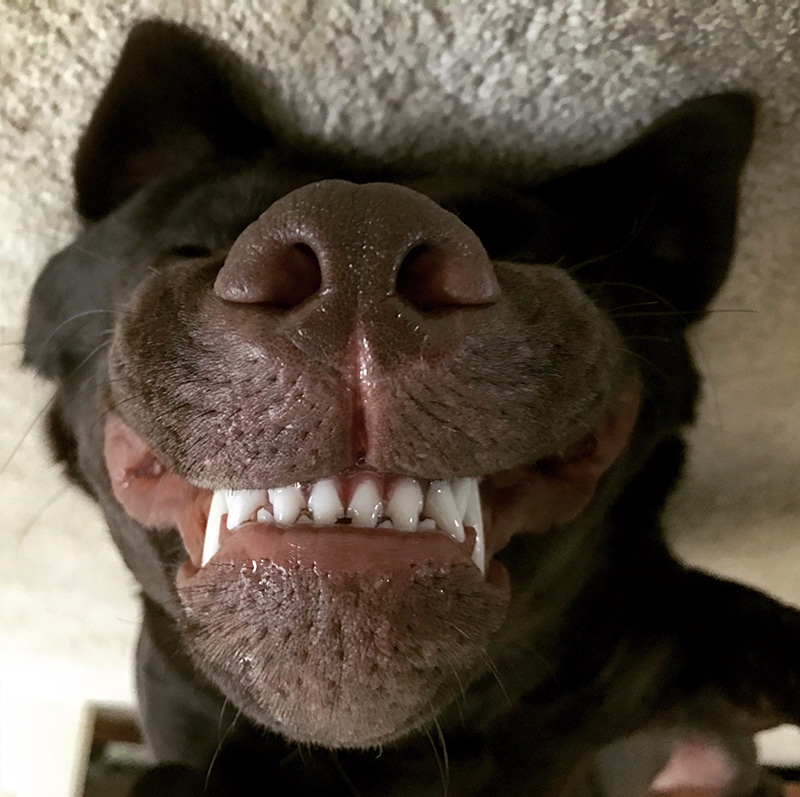
How do I change my lab’s diet?
Any time you want to change your lab’s diet, we recommend you switch gradually over 1-2 weeks. Start by feeding about ¼ of the new food mixed with ¾ of the old food for a few days and gradually change the proportions until you’re feeding 100% of the new formula.
Do Labradors need special dog food?
As long as you’re meeting the nutritional requirements for your dog, you don’t need a special “lab formula” of dog food.
Should I Feed My lab dry or wet food?
As long as you choose a nutritionally balanced formula, you can choose wet or dry food. See our section above about wet versus dry food for some pros and cons of each type.
When is a Labrador considered a senior?
Labradors usually live about 10-12 years and are considered to be seniors at 7 years.
Does my lab need a puppy specific diet?
Labrador puppies should have a food formulated for large breed dogs so that it supplies the proper balance of calcium and phosphorus for rapid long bone growth.
My Labrador is a picky eater, is it ok to free feed him?
We don’t recommend feeding labs free-choice. When you provide a constantly filled food dish, you can’t track intake, and it’s harder to tell if your pooch is off feed and may be sick. Not to mention labs are already prone to obesity, and unrestricted food won’t help that.
How long can a Labrador go without eating?
Provided that your pup is healthy and has access to plenty of water, he can survive up to five days without eating. However, if your pooch skips more than a few meals, take him to the vet for a checkup.
Is milk good for Labradors?
Milk and milk products are generally not good for labradors. any dogs aren’t able to digest lactose, and giving large quantities of milk can cause digestive upsets.
What human food can a Labrador eat?
Canines can eat many of the same foods as humans. You can feed nutritious foods such as lean meats, some fruits and vegetables, rice, and pasta. If you’re sharing table treats, keep them to a minimum.
Why won’t My Labrador eat?
There are several possible reasons that a labrador won’t eat:
- He has a medical condition
- He’s a picky eater
- He’s suffering from depression or anxiety about something
If your pooch isn’t eating, talk to your veterinarian to try to uncover the cause.
Can Chicken Cause Harm to my Labrador?
Cooked chicken is a healthy choice for your Labrador, and many dog foods contain chicken as an ingredient. Unless your pooch is on a raw diet, avoid feeding raw chicken to avoid a Salmonella infection. Additionally, you should not feed chicken bones, as they can splinter and injure the gut.
Do Labradors have a sensitive stomach?
Some Labradors can have food sensitivities or a sensitive stomach that presents as loose stools and flatulence. If your pup suddenly develops diarrhea, check with your veterinarian in case there’s an underlying medical condition. You can choose foods with digestible ingredients and probiotics to help support gut health.
What is the worst food for a Labrador?
Some dangerous foods for labs include grapes or raisins, onions, garlic, macadamia nuts, and anything with xylitol.
The Final Woof
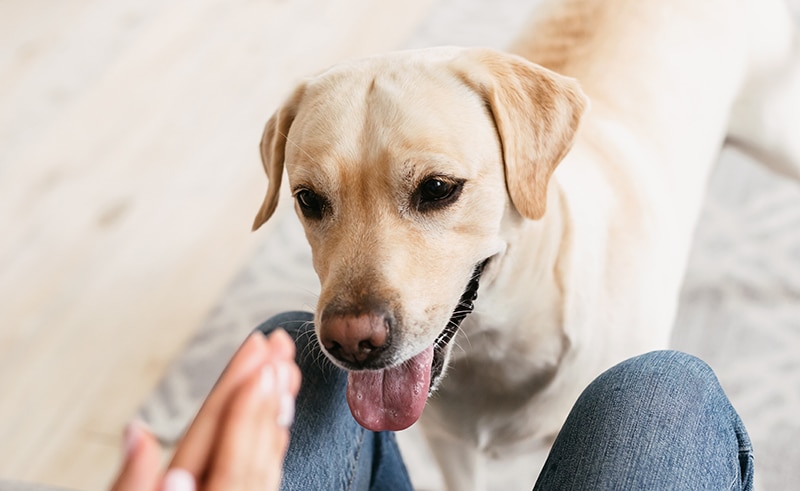
Labradors need a high protein diet with moderate fat to fuel their activity level without adding unneeded weight. As large breed pups, they also benefit from glucosamine and chondroitin to support healthy joints.
Because these dogs can suffer from allergies and sensitive stomachs, they need low-allergen foods that are digestible. Omega fatty acids in the diet help to keep their skin and hair healthy.
When choosing a food for your labrador, it’s wise to consider a diet that includes healthy whole grains. These ingredients provide a natural source of taurine to help support heart health.
After reviewing over 100 foods, we recommend Earthborn Holistic Large Breed Pea-Free Dry Dog Food as the best dog food for labs because it provides the right nutritional balance for overall health.

